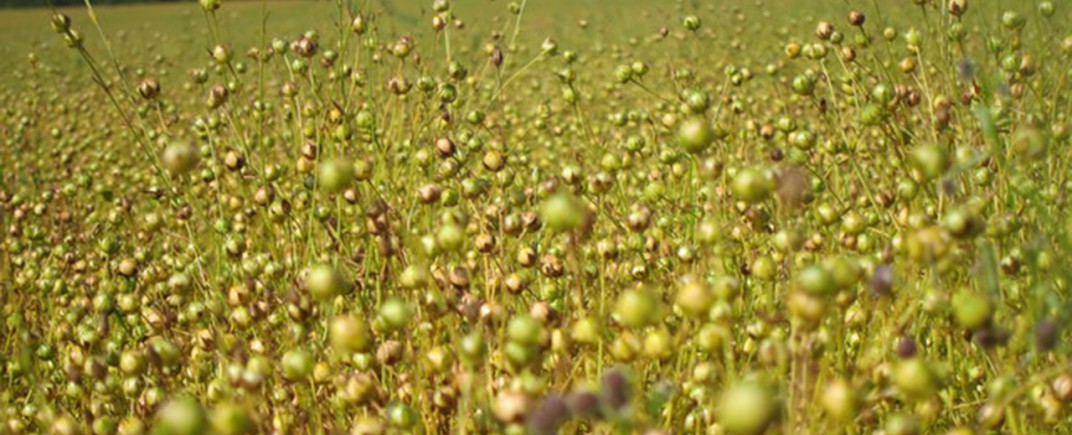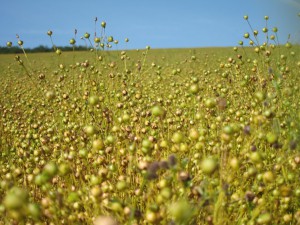Camelina (Camelina sativa L. Crantz) – Profile by Jessica Pratchler
Camelina (Camelina sativa L. Crantz) is an oilseed crop belonging to the Brassicaceae family and is a promising new crop for organic agriculture. This crop, also known as false flax, German sesame, and gold-of-pleasure, is well adapted to cold semi-arid climates and can be used as an edible oil, animal feed, and biofuel (CFIA 2012). The seeds are 45% oil and are particularly high in alpha-linolenic acid, which gives it an added health advantage over other oilseed crops (Kirkhus et al. 2013). Camelina is also rich in tocopherols, which helps it resist oxidation and have a long, stable shelf life (Kirkhus et al. 20013). Outside of these major uses, camelina oil has been used for cosmetics, varnishes, and stalks can be used for pulp fiber and upgraded products (Zubr 2003). Camelina is well adapted to organic agriculture because it is naturally resistant to many pests and is a low nutrient user. Thus pesticides, herbicides, and fertilizers do not need to be applied, in order to produce excellent yields.
Identification
Camelina can be seeded as a winter or summer annual. Plants range from 30 to 90 cm (CFIA 2012). Initially growing in rosette formation (with non lobed leaves), a single erect stem protrudes, which begins to branch near the top. As the plant matures, the rosette, withers away, and is non-present at maturity. The clasping leaves (without a petiole) are alternate, and lance-shaped. 4 small, yellow coloured flowers are plentiful, which allows this species to resemble canola flowers. Fruits are at the terminal ends of the branches, forming racemes, and are botanically named silicles. These structures resemble flax bolls, but are longer and narrow on one end, resembling a teardrop shape. In each silicle, there are many small tan coloured seeds.
Adaptations
Camelina is a short-season crop native to Eastern Europe. Due to maturation of 85 to 100 days, the species is well adapted to northern climates (CFIA 2012). According to the Canadian Food Inspection Agency (2012), the first report of Camelina in Canada was in Manitoba. Since 1863, Camelina has been primarily planted as far west as Peace River, as far north as the Northwest Territories, and throughout the three Prairie Provinces. The species is also sowed in the Yukon and remaining provinces (except Newfoundland), however, it is very rare. In the United States, camelina has been reported throughout all the northern states. Overall, camelina is rated for zones 1 to 9 in the NAPPFAST Plant Hardiness scale, which allows it to be grown almost everywhere.
This species is well suited to organic agriculture due to the minimal need for added nutrients. Kirkhus et al. (2013) found that nitrogen levels, provided by pre-cropping with peas, provide enough nutrients to positively affect camelina oil composition and production. Specifically, increases in alpha linolenic and erucic acid, tocopherols, and campesterol concentrations have been reported in comparison to pre-cropping with barley. Since camelina is a member of the brassica family, special considerations for rotation should take place. It is recommended that camelina should only be grown once every three to four years (CFIA 2012). In warmer climates, camelina can be used as a double crop due to its short growth period (CFIA 2012). Mixed cropping can also occur as camelina provides excellent weed suppression. Mixed cropping generally occurs with peas (Figure 3) but is also used with cereals, as seeds can be easily separated through screening.
Cropping Considerations
Biotic stresses placed on this species are very minimal. Insects that often affect other brassicas, such as diamondback moths and bertha armyworms, can be found on camelina but do not cause significant damage (Kirkhus et al. 2013; CFIA 2012). Camelina is also a good weed competitor. High seeding rates increase the competitive nature of this crop by allowing good crop stand and early maturity (CFIA 2012). Pre-seeding tillage is often sufficient for weed control because camelina emerges early, out competing late germinating weeds, and has allelopathic traits (CFIA 2012). Mix cropping has shown to suppress annual weeds by up to 63% compared to monocropping (Saucke and Ackerman 2006). Therefore, no pesticides or herbicides needed to be used in order to achieve improved yields (Zubr 2003). Camelina, however, is susceptible to a small handful of diseases but does possess natural resistance to blackleg and black spot (CFIA 2012). The diseases affecting camelina and of economic concern are clubroot, white rust, and aster yellows, however, breeding work is currently in place to try and gain resistance (CFIA 2012).
Summary
Overall, camelina is a beneficial crop for organic agriculture due to its intrinsic biology. Well-adapted to cold climates, camelina can be grown in a wide variety of environments, and can be used as a winter or summer annual. Being able to survive in the cold allows camelina to be seeded early and subsequently emerge before many other species. This allows camelina to be a competitive weed species. As an excellent weed competitor, camelina can be used as a mixed or double crop species to reduce weed competition for other cropped species. By utilizing this rotation method, camelina is supplied with enough nutrients, which then do not have to be added. Lastly, there are a few economically damaging pests; however, specific considerations in rotation planning need to take place. This species should be grown only once every 3 to 4 years as many diseases that affect other brassicas and dicots can also affect camelina.
References
Canadian Food Inspection Agency. 2012. The biology of Camelina sativa (L.) Crantz (Camelina). Plant and Biotechnology Risk Assessment Unit. http://www.inspection.gc.ca/plants/plants-with-novel-traits/applicants/directive-94-08/biology-documents/camelina-sativa-l-/eng/1330971423348/1330971509470. Accessed: February 15, 2014.
Canpressco. 2014. Three farmers camelina oil: the only cold-pressed artisanal oil of its kind. Threefarmers.ca Accessed: February 15, 2014
Kirkhus, B., Lundon, A.R., Haugen, J.E., Vogt, G., Borage, G.I.A., and Henriksen, B.I.F. 2013. Effects of environmental factors on edible oil quality of organically grown Camelina sativa. J. Agric. Food Chem. 61. 3179-3185 pp.
Plant Systematics. 2006. Brassicaceae: Camelna sativa. http://www.plantsystematics.org/imgs/ws1/r/Brassicaceae_Camelina_sativa_26288.html Accessed: February 15, 2014
Saucke, H. and Ackerman, K. 2006. Weed suppression in mixed cropped grain peas and false flax (Camelna sativa). Weed Research 46: 453-461 pp.
University of Idaho. 2012. Biodiesel education: A new paradigm in lifecycle analysis. http://opal.cals.uidaho.edu/biodiesel/ Accessed: February 15, 2014.
Zubr, J. 2003. Qualitative variation of Camelina sativa seed from different locations. Industrial crops and products 17. 161-169 pp.


